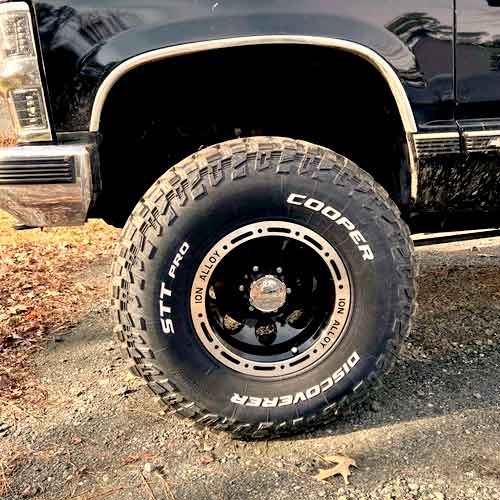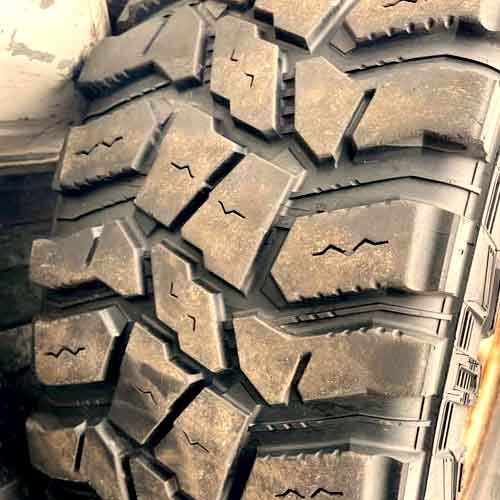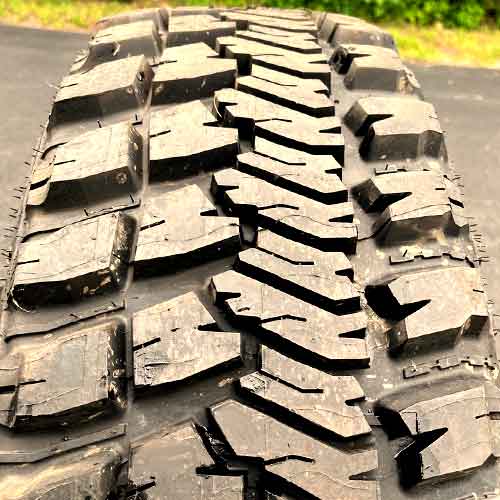The tire industry is seeing a major shift towards innovative designs and superior performance, and both the Goodyear Wrangler MT/R and the Cooper STT Pro are leading the way with their mud-terrain tire offerings. Let’s take a closer look at their performance.

As a tire engineer, my tests show that the Cooper STT Pro delivers better results when it comes to dry handling, but could use some help on wet. And off road, it renders superior traction on rocks, sand and muddy terrains. Goodyear Wrangler M/TR on the other side, provides better wet grip on highways, better fuel economy, tread life and off-road it’s although lacking to its counterpart, its not by a lot.
Table of Contents
Tread Design
The Cooper Discoverer STT Pro is a tire that offers exceptional performance on both rough and smooth roads due to its unique features.

Its three main lugs (in the middle) have offset edges and reinforced foundations, providing stable grip on highways combined with off-road bite.
For wet traction, these lugs are also equipped with interlocking sipes, and although they are not as wide, they are good enough, still, (for a mud tire).
These blocks in the middle, although make quite some longitudinal grooves, they are nothing compared to wider lateral channels.
These channels are mostly made by shoulder blocks, as they cover the majority of the tread’s area.
There are actually two types of lugs there, and they vary a lot form each other.
On one, there are sharp biters, and sipes, while the other elongated one has longitudinal notches.
The Goodyear Wrangler MT/R on the other side, features a more aggressive two faced design.

It’s asymmetric design creates 4 unique ribs, each having lugs of different geometry.
The 2 ribs in the middle contain elongated, and closed up lugs on one side, and thicker, on the other.
All of these carry full depth notches and a little bit of siping.
The shoulder blocks on both sides of the tire, also vary significantly, with one side having minimal tread features and a squared-off design, whereas the other side having shoulder blocks with prominent V shaped biters.
Lastly, examining the tire’s sidewalls, you’d find that it’s lugs are not as aggressive, as one would expect (especially after looking at things in the middle).
Although they are Kevlar-reinforced from underneath, the N shaped lugs on top is not as thicker as the Cooper STT Pro.
Must-Know Facts
The Cooper Discoverer STT Pro offers 49 total sizes in 15″ to 22″ rim sizes, coming with following specs.
- All have speed rating of Q.
- Load Ratings: C to F.
- Weight Range: 42 lbs to 94 lbs.
- Tread Depth Range: 18 to 22/32″, where most of the sizes get to have 21/32″.
The Goodyear Wrangler MTR comes in average sizes availability, going from 15 to 20 inches (rim diameter).
- Speed Ratings of Q.
- Load Range: C, D and E.
- Weight Range: 47 to 91 lbs.
- Tread depth: 18, 19 or 21/32″ on all sizes.
Wet Traction
Wet traction depends on water removal abilities, and although both tires are pretty voided and most of the water gets to channel out through their grooves easily, the little bit that gets left isn’t dealt with effectively, because of the limited sipes on both tires.
Though still, the Goodyear Wrangler M/TR is better off, if you compare these two.
That’s because for one, this tire provides rounded contact patch, so water gets to leave out more efficiently, and two, it provides more sipes, especially in the middle, and with rounded contact patch, these sipes gets to be more effective comparatively.
The Cooper STT Pro on the other side, has limited siping and it’s stiffer tread don’t’ allow them to have the needed flexibility so it lacks here overall.
Highway Traction
To properly evaluate the dry performance of mud tires, we need to consider grip, steering, and handling (discussed in the same order below).
Grip
The section width and contact patch of a tire are the primary dimensions that impact “dry” grip, and although other factors such as rolling resistance, weight, and rubber composition are also relevant, you’d be surprised to note that both tires are very similar in them.
But still you get to see shorter braking distances with Wrangler MTR (this is how directional grip gets calculated).
So why is that? Well, that’s because this tire offers better footprint, with its closed up lugs, and so more friction gets generated and with it the directional traction.
Handling
The second part of traction is dependent on handling times (which tell how fast a tire covers laps on average), and here, both tires show similar results, despite Cooper STT pro being more voided.
That’s because this tire provides elongated lugs, and since during turns, shoulders get to bear most of the tire’s weight, it provides superior handling abilities.
The Wrangler M/TR though on the other side, is only off by less than a second.
Steering Sensitivity
Steering sensitivity, is a crucial performance metric that tells how fast can a tire be maneuvered.
And out of both tires, the Goodyear Wrangler M/TR provides better.
This tire is actually similar weighing, and has same kind of tread composition and depth, but as it provides a more consistent connection with the road during rolling (due to it’s closed up tread blocks), it’s provides better steering response.
The Cooper Discoverer STT Pro on the other side, is more voided, and it’s design doesn’t allow it to do the same.
Snow Performance
On snow, there are a lot of variations, ice, road snow, deep snow, off-road, and so on.
And out of all these terrain types, the mud terrain tires only do good with deeper snow. As for on road snow, they show a lot of slippage, and for ice, they are straight up dangerous, as they don’t offer any kind of traction over there.
That’s why these tires are not 3 peak mountain snowflake rated. If you see one let me know, I don’t think any mud tire with that rating exist.
Though still out of these boys here, the Goodyear Wrangler M/TR provides better efficacy.
That’s because on snow heavier tire with trapping grooves do good. So with a lot of biters the MTR gets to lodge more snow in its grooves and make much better snow to snow contact.
(Snowflakes have an intermingling design, so they get stuck with each other, that’s why rubber to snow is not as effective, as snow to snow, which produces more friction).
The Cooper STT pro is although not good enough, its still provides the scooping, which is also pretty effective as well. It’s lateral grooves as I explained above provide good enough results.
Internal Construction
Durability depends on how many plies are there in the tires internal make up.
But the more the no. of plies, the heavier the weight, which then causes limited fuel efficiency and grip response (stating the main ones).
That’s why both tires only offer a single nylon cap ply on the very top (underneath tread), though they both have 3 ply polyester carcass and 2 wide steel belts as well (so both have 3 ply sidewalls, which is a M/T-standard).
Off Road Traction
To excel in off-road conditions, tires should have strong self-cleaning abilities to shed debris and maintain traction. They should also be able to navigate rough terrain and have sturdy LT sizes with thick lugs to handle the weight of the vehicle.
On Mud
On mud you need two things, faster evacuation and scooping, and Cooper STT Pro provides both.
With a more voided design its able to channel out the excess mud out (while the middle lugs break it down). And with elongated shoulders it’s provides the paddling on the mud, throwing thick mud backwards and creating forward facing force out of it.
(Consider its tread again, and see how it’s asymmetric design creates swooping lateral grooves).
The Goodyear Wrangler MTR on the other side, is neither so open, nor is scooping. The tire’s central area is more packed up, and there are no proper lateral channels that can provide the “scoops”.
Moreover, with minimalist design on sidewalls, it’s lugs there aren’t helping either.
Performance on Rocks
Cooper Discoverer STT Pro is rated as one of top performing tires on rocky terrains.
The tire basically provides a great gripping capability form all sides.
If you consider its tread again (by scrolling to its section), you’d note that it yields much more aggressive shoulder/sidewall lugs (with notches), and with lowered pressure they create epic biting power.
You’d also see that the the tire also makes wide enough lateral grooves, (they almost form a wave like pattern) and this really helps it with directional grip.
The Goodyear Wrangler M/TR on the other side, really lacks in providing lateral traction, with it’s less biting sidewall lugs. Though it’s asymmetric pattern does great with rock climbing (directional traction).
On Sand
With Kelvar reinforced sidewalls, the Wrangler MTR gets to have very stiffer sides, and these combined with it’s sharper shoulder lugs, this tire simply provides more digging.
Digging is the worst thing for sand, as it forces a tire to get stuck, and you don’t want to go inside the sand, you need to move forward.
So although both tires weight almost the same, with a smoother edges, you see better sand traction on Cooper Discoverer STT Pro.
Fuel Usage
The fuel efficiency of a tire is affected by its rolling resistance, which is dependent on the tread depth, composition, and weight.
And although both tires have similar weight and tread depth, the Goodyear Wrangler M/TR shows lower rolling resistance values.
That’s because with compacted design of the lugs (in comparison), the similar weight is distributed on a larger rubber area, so it consumes less fuel as a result.
Tread Life
Tread life depends on durability of the tire, and both tires re pretty durable, having strong cut resistant rubber on top.
Though still the Cooper STT Pro as it get to produce more rolling resistance gets to burn off faster as well.
The Goodyear Wrangler M/TR on the other side is also not so great, its still better in comparison, even though the tire weighs more, it’s closed up lugs evenly distributes the pressure, so each of its lug don’t get to burn off the road with as much force as the Cooper’s M/T.
Takeaway Points
Out of both tires, the Cooper Discoverer STT Pro provides superior traction on rocks, and better mud and sand performance as well.
Whereas the Wrangler M/TR is better off for dry and wet roads, and it’s compound is a better seasonal tire as well, that’s why you get extra winter traction with it as well.